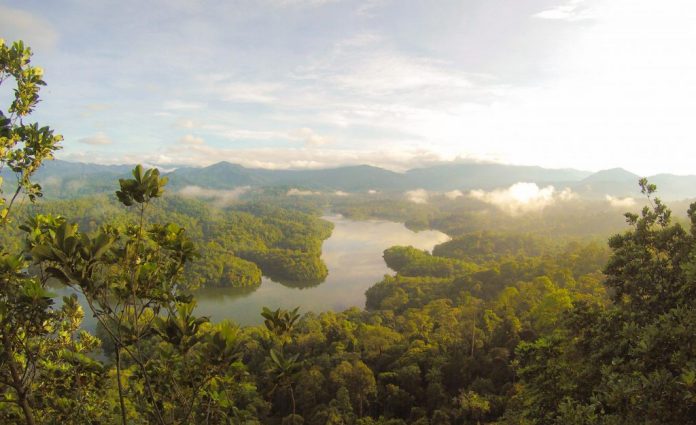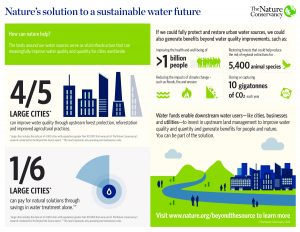By Caterina Marinetti
Nature-based solutions are already in place and scaling them up is possible
Nature-based Solutions (NBS) applications [1] are many around the world. However, their cases are often isolated or pilot studies, and the concept of NBS is being shaped, acknowledged and shared only now. NBS upscaling demands for improved knowledge base, the creation of attractive business cases, cross-sectoral and multi-scalar cooperation[2].
Rethinking the way we manage and interact with the ecosystems
Overall, the need to use more sustainable solutions that also take into account the ecosystems is a consensus. But what are the barriers to reach this? Or, how can we embed NBS in local practice and scale it up?
So far, civil engineering has dominated the building sector, erecting rigid and ‘inflexible’ infrastructures. Future developments for new and more adaptable solutions find their way right at this moment. As Ms. Madgwick, CEO of Wetland International, stated during the BwN Conference last month[3], “the need to upscale NBS originates from grey infrastructures’ side effects, their malfunctioning and environmental damages”. The call for maintenance of ageing constructions creates opportunities to integrate NBS in the urban and rural landscapes. Such integration comes with added benefits, since NBS represent viable and adaptive means for a sustainable development, to face new challenges posed by demographic growth and climate change, and contribute to reach SDGs as 6.1.
After having agreed on the needs to implement NBS, the challenge is to go from pilots to projects upscaling and investments. That is: reaching the embedment of NBS into society and economy. The priority issues to make this step happen can be gathered in three main categories: technical base, finance and governance (Table 1). Improving scientific evidence lies at the heart, but new layers are to be added, starting from creating business cases for NBS and revising current governance models. Governance settings “are made up of silos, with little collaboration and few integrated solutions” says Mr Hugtenburg from ARK Natuurontwikkeling[3], “we need to see nature not as an item of men, but as underlying principle that we need to enable. And enabling requires involvement at all scales”.
Table 1. Priority issues needed to scale up NBS implementation[4]
| Priority issues | |
| Technical upscaling |
|
| Financial upscaling |
|
| Governance: upscaling requires others |
|
IWA is pioneering the dialogue among regulators
Means for NBS enablement exist in current policies, legislations and regulatory frameworks. However, the uptake of policies and measures often faces barriers of complex interpretations [6]. In this context, regulators can help bridging the gap between policies and practice. They can set criteria, standards, targets and tools to enable NBS upscaling, by rethinking about goals and the way services are regulated. Regulators can find ways to leverage investments and provide new tariff methodologies, e.g. to include NBS related-costs into users’ fees. They can act at different levels influencing projects from the early phases, and encouraging the incorporation of green and grey infrastructures, e.g. through building codes.
“Complying with standards, as regards NBS’ functional specifications, is the primary concern for engineering companies” has stated Mr Osinga from ECOncrete [3]. If such standards are set by regulators, and they influence companies and clients’ decisions and investments, doesn’t this mean that regulators are key players? Indeed, NBS upscaling and replicability highly depend on regulations. However, there is an urgent need for regulators to identify priority issues and gaps to upscale NBS implementation for water management and resiliency in the diverse governance contexts.
This is one of the primary efforts of the IWA Water Policy and Regulation area of work. A few months ago, in partnership with The Nature Conservancy (TNC), the area started a joint research “Building nature-based, resilient water systems: Catalysing the Role of Water Regulators”, with the objective to support the information needed for ensuring policies and regulations that promote NBS in water management, as basis for resilient and sustainable universal access to water and sanitation for all. Through a Task Force, IWA is creating a global network to exchange experiences and lessons learnt, and to identify which environmental, economic and social regulations are coming into place that have effects on business opportunities for NBS, stakeholders participation, and for reaching the SDGs 6.1. and 6.6. The water regulator work is being complemented by research into the demand for nature based solutions by water utilities. This includes looking at what are the elements of success and how regulators working with utilities can create incentives for integration of nature into built water systems.
Find out more about this work through the following events and resources:
IWA and TNC host a sofa at the Stockholm World Water Week
Water Utilities’ Leadership in nature-based solutions
Monday 27 August 14:00 – 14.30 / Corner of the exhibition area of Folkets Hus
Achieving water security is fundamental to sustainable economic and human development; and managing natural infrastructure for water security can support the delivery of many – if not all – of the UN Sustainable Development Goals.
Upstream watershed protection is recognized as a cost-effective and efficient approach to increasing the security and resilience of urban water supplies. But investment in natural infrastructure has yet to be widely adopted as a mainstream solution by local administrations and the utility sector, both of which have a critical role to play in the provision of secure and sustainable water to urban populations.
A recent partnership between the International Water Association (IWA) and The Nature Conservancy (TNC) aims to leverage the two organisations’ strengths to influence greater investments in watershed protection.
During the sofa, Helmut Kroiss, former President of the International Water Association, Andrea Erickson, Acting Global Managing Director for Water, The Nature Conservancy, and Philip Gichuki, CEO, Kiambu Water Company, will examine the relevance of nature-based solutions for water security.
More information about the event on IWA Connect and on the Stockholm World Water Week website. The sofa will be broadcasted live via www.vimeo.com/siwi and available to view afterwards.
Webinar On-Demand
Last August 9th, IWA and The Nature Conservancy organized the Webinar “Building nature-based, resilient water systems: Catalysing the role of Water Regulators”. Watch the webinar recording online upon registration. Continue the discussion with the speakers on the related group on IWA Connect and get involved! Please remember you need to subscribe and be logged in to IWA Connect to view the group discussion.
IWA and TNC at the IWA World Water Congress & Exhibition, 16-21 September 2018, Tokyo, Japan
The partnership between TNC and IWA aims at contributing new insights on how regulators can shape behaviour to favour the incorporation of NBS into water systems. If you’re attending the IWA World Water Congress, come join us at the 5th International Regulators Forum.
References
[1] “Actions to protect, sustainably manage, and restore natural or modified ecosystems, that address societal challenges effectively and adaptively, simultaneously providing human and biodiversity benefits” (IUCN, 2016:5). These include solutions to water-related issues as: restoring and managing wetlands and rivers to reduce flood risk; developing green infrastructures in urban areas to reduce stormwater runoff; etc.
[2] Conferences and initiatives worldwide are launching a call to scale up NBS – see the UN World Water Assessment Programme (WWAP, 2018), the European Commission policy agenda on NBS (EC, 2015), the IUCN work by the Commission on Ecosystem Management (IUCN, 2016), IWA activities on NBS (IWA, 2018), or the Netherlands National Committee for NBS for water (IHP-HWRP, 2018).
[3] Quotes from speakers at the Conference Upscaling Building with Nature (BwN) organized by EcoShape, in Utrecht (NL) on June 27, 2018. BwN includes the use of Nature-based Solutions (NBS).
[4] The list has been developed readapting keynotes from the BwN Conference3 and previous desk research.
[5] System of Environmental-Economic Accounting, by the UN Statistics Division (SEEA); Common International Classification of Ecosystem Services (CICES)









